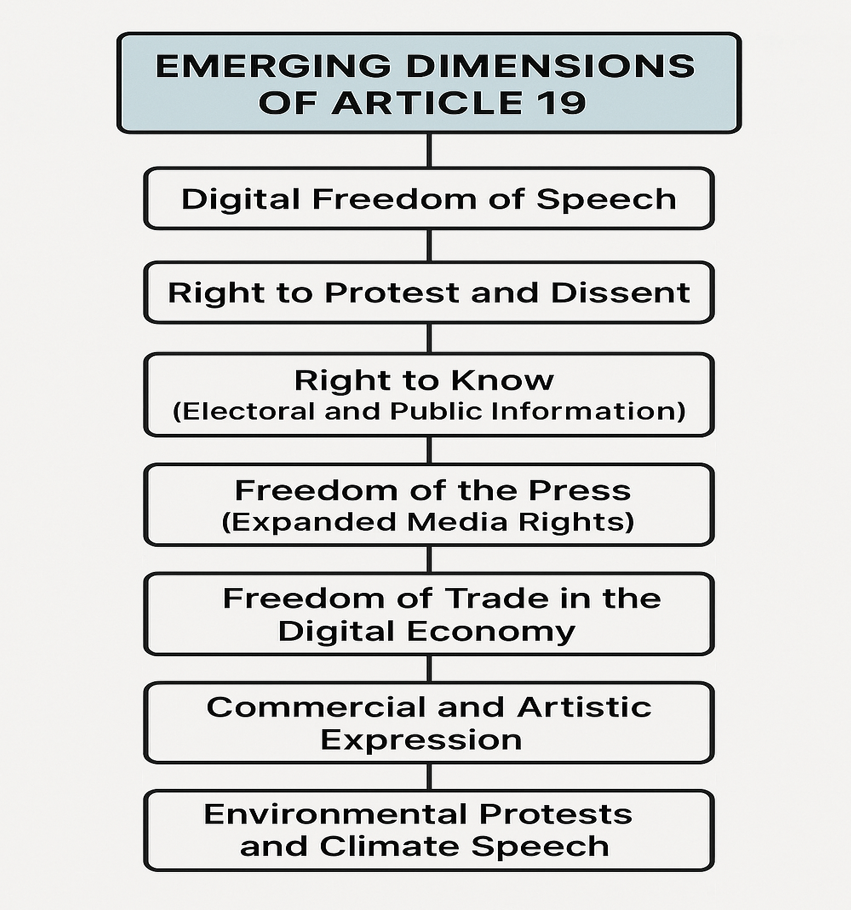There are no items in your cart
Add More
Add More
| Item Details | Price | ||
|---|---|---|---|
Mon Jun 30, 2025
పరిచయం:
స్వేచ్ఛ అనేది భయం లేకుండా మాట్లాడడం మాత్రమే కాదు వినడం, సమాచారం పొందడం మరియు ఎంపిక చేసుకోగల సామర్థ్యం కూడా. భారత రాజ్యాంగంలోని 19(1)(a) అధికరణ పౌరులకు ఈ క్రింది హక్కును అందిస్తుంది—వ్యక్తీకరణ, రాయడం, సంజ్ఞలు చేయడం లేదా ఏ రూపంలోనైనా సమాచారాన్ని తెలియజేయడం. ఇది మన ప్రజాస్వామ్య భావనలో ఉండడం వల్ల ప్రజలు, సామాజిక మరియు రాజకీయ జీవితంలో చురుకుగా పాల్గొనేందుకు వీలు కల్పిస్తుంది.
విషయం:
A.వాక్ మరియు భావ వ్యక్తీకరణ స్వాతంత్ర్యం యొక్క స్వభావం మరియు విస్తృతి:
స్వభావం:
1. మౌలికమైనది మరియు రాజ్యాంగబద్ధమైనది:
a. 19(1)(a) అధికరణ భారత పౌరులందరికీ వాక్ మరియు వ్యక్తీకరణ స్వాతంత్ర్యాన్ని ఇస్తుంది.
b. రాజ్యాంగ పీఠిక నుండి తాత్విక మద్దతు పొందుతూ, ఆలోచన మరియు వ్యక్తీకరణ స్వేచ్ఛను నిర్ధారిస్తుంది.
2. ప్రత్యేకంగా భారత పౌరులకు :
-ఈ హక్కు విదేశీ పౌరులకు లేదా పౌరులుగా అర్హత లేని చట్టపరమైన సంస్థలకు అందుబాటులో ఉండదు.
3. పరిమితం కాని స్వభావం:
-19(2)వ అధికరణ ప్రకారం చట్టాల ద్వారా ఈ హక్కును సహేతుకంగా నియంత్రించవచ్చు:
a. భారతదేశ సార్వభౌమత్వం మరియు సమగ్రత
b. దేశ భద్రత
c. ప్రజా వ్యవస్థ
d. ఔచిత్యం లేదా నీతి
e. కోర్టు అవమానం
f. అపవాదం
g. నేరానికి ప్రేరేపణ
h. విదేశాలతో స్నేహపూర్వక సంబంధాలు
4. మాధ్యమ-తటస్థ వ్యక్తీకరణ:
-మాటలు, రాత, దృశ్య, డిజిటల్ లేదా సంకేత రూపంలో ఏ వేదిక ద్వారా అయినా సమాచారాన్ని తెలియజేసే స్వేచ్ఛను కలిగి ఉంటుంది.
5. వ్యక్తీకరణ మరియు మౌనం రెండింటినీ రక్షిస్తుంది:
-బిజో ఇమ్మాన్యుయల్ వర్సెస్ స్టేట్ ఆఫ్ కేరళ (1986) కేసులో మౌనంగా ఉండే హక్కును కూడా గుర్తించారు.
B. విస్తృతి: సుప్రీం కోర్టు ఆర్టికల్ 19(1)(a)ని విస్తరించి ఈ క్రింది అంశాలను చేర్చింది:
1. పత్రికా స్వాతంత్ర్యం:
-స్పష్టంగా పేర్కొనకపోయినప్పటికీ, రోమేష్ థాపర్ వర్సెస్ స్టేట్ ఆఫ్ మద్రాస్ (1950) కేసులో పత్రికా స్వాతంత్ర్యం ఈ హక్కు యొక్క ముఖ్యమైన అంశంగా గుర్తించబడింది.
2. వాణిజ్య వాక్ స్వాతంత్ర్యం:
-నైతికత మరియు వినియోగదారుల రక్షణ చట్టాలకు లోబడి, ప్రకటనలు మరియు వ్యాపార సంబంధిత సమాచారాన్ని కలిగి ఉంటుంది.
3. మౌనంగా ఉండే హక్కు:
-బిజో ఇమ్మాన్యుయల్ వర్సెస్ స్టేట్ ఆఫ్ కేరళ (1986) కేసులో, మతపరమైన కారణాలతో జాతీయ గీతాన్ని పాడకపోవడం ఈ హక్కులో భాగమని సుప్రీం కోర్టు ధృవీకరించింది.
4. ప్రతిస్పందన హక్కు:-
-LIC వర్సెస్ మనుభాయ్ డి. షా (1992) కేసులో, అపవాదకర లేదా తప్పుదారి పట్టించే కంటెంట్కు సమాధానం ఇవ్వడానికి వ్యక్తికి హక్కు ఉందని కోర్టు గుర్తించింది.
5. ప్రసార మరియు టెలికాస్ట్ హక్కు:
-సెక్రటరీ, ఇన్ఫర్మేషన్ అండ్ బ్రాడ్కాస్టింగ్ వర్సెస్ CAB (1995) కేసులో, ఎలక్ట్రానిక్ మీడియాపై ప్రభుత్వానికి గుత్తాధిపత్యం లేదని తెలియజేసింది.
6. సమాచార హక్కు:
-పౌరులకు ప్రభుత్వం వద్ద ఉన్న సమాచారాన్ని పొందే హక్కు ఉంది. ఇది RTI చట్టం (2005)కు ఆధారం. రాజ్ నారాయణ్ వర్సెస్ స్టేట్ ఆఫ్ UP కేసులో ఇది మౌలిక హక్కుగా ప్రకటించబడింది
7. విమర్శ హక్కు:
-ప్రభుత్వ విధానాలు మరియు చర్యలను స్వేచ్ఛగా విమర్శించవచ్చు. అయితే ఇది రాజద్రోహం లేదా అపవాదం రేకెత్తించే స్థాయికి వెళ్లకూడదు.
8. ముందస్తు సెన్సార్షిప్కు వ్యతిరేక హక్కు:
-వార్తాపత్రికలపై ముందస్తు సెన్సార్షిప్ అనేది ఈ హక్కును ఉల్లంఘిస్తుంది.
9. ప్రదర్శన/పికెటింగ్ హక్కు:
-శాంతియుత నిరసనలు అనుమతించబడతాయి. అయితే సమ్మె అనేది ఆర్టికల్ 19(1)(a) కింద రక్షింపబడదు.
C. భారతదేశంలో స్వాతంత్ర్య హక్కు యొక్క విస్తరణ:
1. అభ్యర్థుల నేపథ్యం తెలుసుకునే హక్కు:
-అసోసియేషన్ ఫర్ డెమోక్రటిక్ రిఫార్మ్స్ (2002) కేసులో, ఓటర్లు అభ్యర్థుల నేర చరిత్ర మరియు ఆర్థిక నేపథ్యాన్ని తెలుసుకునే మౌలిక హక్కు కలిగి ఉన్నారని కోర్టు తీర్పు ఇచ్చింది.
2. జాతీయ జెండా ఎగరవేయడం:
-యూనియన్ ఆఫ్ ఇండియా వర్సెస్ నవీన్ జిందాల్ (2004) కేసులో, గౌరవంతో జాతీయ జెండాను ఎగరవేయడం దేశభక్తి వ్యక్తీకరణ రూపంగా ఉంటుంది అని సుప్రీం కోర్టు ప్రకటించింది.
3. డిజిటల్ వాక్ స్వాతంత్ర్యం:
-శ్రేయ సింగల్ వర్సెస్ యూనియన్ ఆఫ్ ఇండియా (2015) కేసులో, IT చట్టంలోని సెక్షన్ 66Aని సుప్రీం కోర్టు రద్దు చేసింది. ఆన్లైన్ వ్యక్తీకరణ ఆర్టికల్ 19(1)(a) కింద పూర్తిగా రక్షించబడుతుందని నిర్ధారించింది.
4. నిరసన మరియు విభేద హక్కు:
-షహీన్ బాగ్ (2019–20) మరియు రైతు నిరసనలు వంటి శాంతియుత ఉద్యమాలు ప్రజా విభేద హక్కును తెలియజేస్తుంది.
5. సమాచార హక్కు (ఎన్నికల మరియు ప్రజా సమాచారం):
-బ్రజేష్ సింగ్ వర్సెస్ సునీల్ అరోరా (2021) కేసులో, అభ్యర్థులు నామినేషన్ దాఖలు చేయడానికి 48 గంటలు లేదా 2 వారాల ముందు నేర చరిత్రను వెల్లడించాలని సుప్రీం కోర్టు ఆదేశించింది.
6. పత్రికా స్వాతంత్ర్యం (విస్తరిత మీడియా హక్కులు):
-ఆర్టికల్ 19(1)(a)లో పత్రికా స్వేచ్ఛ స్పష్టంగా పేర్కొనకపోయినప్పటికీ, డిజిటల్ జర్నలిజం, OTT కంటెంట్ మరియు స్వతంత్ర ఆన్లైన్ మీడియాకు విస్తరించబడింది.
7. డిజిటల్ ఆర్థిక వ్యవస్థలో వాణిజ్య స్వాతంత్ర్యం:
-ఆర్టికల్ 19(1)(g) డిజిటల్ వ్యవస్థాపకత, యాప్ ఆధారిత వ్యాపారాలు మరియు గిగ్ ఎకానమీ హక్కులను రక్షించడానికి విస్తరించింది.
8. వాణిజ్య మరియు కళాత్మక వ్యక్తీకరణ:
-సినిమా, కళ మరియు ప్రకటనలు నైతికత మరియు ప్రజా వ్యవస్థ ప్రమాణాలను పాటిస్తే అవి వాక్ స్వాతంత్ర్యం కింద రక్షించబడతాయి (KA అబ్బాస్ కేసు).
9. పర్యావరణ నిరసనలు మరియు వాతావరణ స్వేచ్ఛ:
a. పర్యావరణ రక్షకులు అభివృద్ధి ప్రాజెక్టులకు వ్యతిరేకంగా నిరసనలకు ఆర్టికల్ 19 హక్కులను ఉపయోగిస్తారు.
b. పర్యావరణ స్వేచ్ఛను రక్షించడం అనేది వాతావరణ ఉద్యమాలు పెరుగుతున్న నేపథ్యంలో ఒక ఉద్భవిస్తున్న సమస్య.
c. ఉదాహరణ – సోనమ్ వాంగ్చుక్ లడఖ్ వాతావరణ నిరాహార దీక్ష (2024):
లడఖ్ యొక్క పర్యావరణ రక్షణ కోసం ఆరవ షెడ్యూల్ ని డిమాండ్ చేస్తూ శాంతియుత ఆమరణ నిరాహార దీక్ష మరియు ఊరేగింపు ఆర్టికల్ 19(1)(a) మరియు 19(1)(b)లను ఉపయోగించింది.

ముగింపు:
ఆర్టికల్ 19 యొక్క విశాలమైన విస్తృతి స్వేచ్ఛ, స్వాతంత్ర్యాలకు దీపస్తంభంగా పనిచేస్తుంది. పౌరులు మాట్లాడేందుకు, పాల్గొనేందుకు మరియు విభేదించేందుకు రాజ్యాంగ హక్కును కల్పిస్తుంది. ఇది వ్యక్తులకు ప్రజాస్వామ్య చర్చలో పాల్గొనడమే కాకుండా, అన్యాయమైన అధికారాన్ని ఎదిరించే శక్తిని కూడా అందిస్తుంది—స్వేచ్ఛ ఒక శక్తివంతమైన ప్రజాస్వామ్యంలో దేశ అన్యాయ చర్యలకు వ్యతిరేకంగా రక్షణ కవచంగా ఉంటుందని నిర్ధారిస్తుంది.